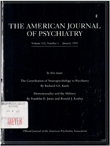Body dysmorphic disorder: 30 cases of imagined ugliness
Abstract
OBJECTIVE: Body dysmorphic disorder, preoccupation with an imagined defect in appearance, is included in DSM-III-R but has received little empirical study. The authors investigated the demographics, phenomenology, course, associated psychopathology, family history, and response to treatment in a series of 30 patients with the disorder. METHOD: The patients (including 12 whose preoccupation was of probable delusional intensity) were assessed with a semistructured interview and the Structural Clinical Interview for DSM-III-R, and their family histories were obtained. RESULTS: The 17 men and 13 women reported a lifetime average of four bodily preoccupations, most commonly "defects" of the hair, nose, and skin. The average age at onset of body dysmorphic disorder was 15 years, and the average duration was 18 years. Seventy-three percent of the patients reported associated ideas or delusions of reference; 73%, excessive mirror checking; and 63%, attempts to camouflage their "deformities." As a result of their symptoms, 97% avoided usual social and occupational activities, 30% had been housebound, and 17% had made suicide attempts. Ninety-three percent of the patients had an associated lifetime diagnosis of a major mood disorder; 33%, a psychotic disorder; and 73%, an anxiety disorder. The patients generally responded poorly to surgical, dermatologic, and dental treatments and to adequate trials of most psychotropic medications, with the exception of fluoxetine and clomipramine (to which more than half had a complete or partial response). CONCLUSIONS: This often secret, chronic disorder can cause considerable distress and impairment, may be related to obsessive-compulsive disorder or mood disorder, and may respond to serotonin reuptake-blocking antidepressants.
Access content
To read the fulltext, please use one of the options below to sign in or purchase access.- Personal login
- Institutional Login
- Sign in via OpenAthens
- Register for access
-
Please login/register if you wish to pair your device and check access availability.
Not a subscriber?
PsychiatryOnline subscription options offer access to the DSM-5 library, books, journals, CME, and patient resources. This all-in-one virtual library provides psychiatrists and mental health professionals with key resources for diagnosis, treatment, research, and professional development.
Need more help? PsychiatryOnline Customer Service may be reached by emailing [email protected] or by calling 800-368-5777 (in the U.S.) or 703-907-7322 (outside the U.S.).



